Managing Disc Herniation and Alleviating Sciatica: Tips and Tricks 1
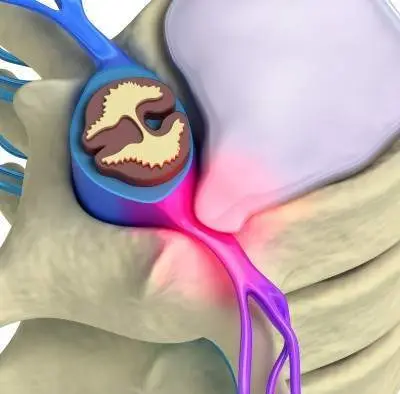
Suffering from disc herniation? Experiencing sharp pains shooting through your buttock, thigh, and leg due to sciatica? If your daily routine is disrupted by the discomfort of disc herniation, there’s hope. Many people find relief without needing surgery. This post will guide you through lifestyle changes to support your recovery from disc herniation. Stay tuned for our next piece, where we’ll explore exercises to correct and stabilize your condition.
Ultimate Guide To Exercises For Lumbar Disc Herniation Relief
Mary’s Story: A Wake-Up Call
Imagine starting your day like any other, performing your routine toe touches, when suddenly you’re hit with an excruciating pain radiating from your lower back down to your toes. This was Mary’s reality when she encountered a lumbar disc herniation, commonly referred to as a slipped or ruptured disc. Such incidents can lead to what’s known as sciatica or radiculopathy, terms doctors use to describe the pain that extends down your leg.
Understanding Lumbar Disc Herniation:
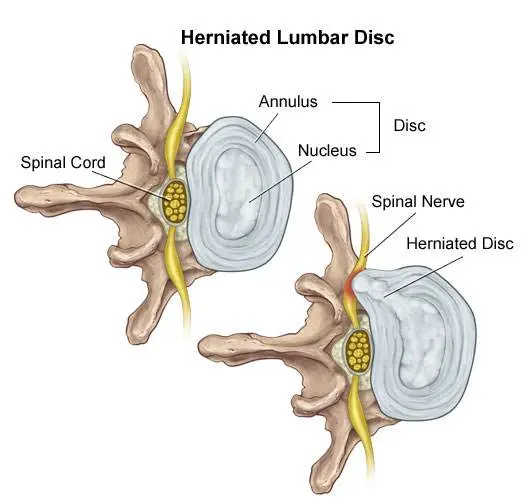
A glimpse into the anatomy of a herniated disc reveals two main components: the tough outer annulus and the softer, inner nucleus. Dr. Stuart McGill likens the nucleus to sticky phlegm. When Mary bent forward, it was akin to squeezing the front of a jelly doughnut, pushing the inner material backwards and eventually causing the disc to bulge and press on a nerve.
The Culprit Behind the Pain:
Mary’s disc herniation wasn’t a sudden mishap but the result of years of repetitive motions like toe touching and prolonged slouching at her desk. These habits gradually weakened her disc, leading to the moment when it finally herniated and impacted her nerve. The lack of nerves within the disc itself means significant damage can occur without immediate pain, explaining why the problem might not be felt until it’s severe.
A Lesson Learned:
The story underscores the importance of posture and the dangers of neglecting spinal health. While the advice to “sit up straight” might seem simplistic, maintaining the natural curve of your back is crucial. Mary’s experience serves as a potent reminder of the long-term consequences of poor posture.
Disc herniations don’t have to dictate your life. By understanding the causes and adopting preventive measures, you can manage and alleviate your symptoms.
Understanding Disc Herniation: Pain, Prevention, and Care
The Unseen Progression of Disc Herniation (see picture above)
- Bulging Disc: Early stages where the disc starts to protrude due to wear and tear.
- Prolapsed Disc: The disc bulges more as it degenerates, but the nucleus remains contained.
- Extruded Disc: The protective layers give way, pressing on nerves and causing pain.
- Sequestrated Disc: The most severe stage, where disc fragments break away, potentially compressing nerves or the spinal cord.
See Also: MRI, CT scan and X-rays: Is an MRI, CT Scan or X-ray Best For My Pain?
Why Me? The Role of Movement and Genetics in Disc Herniations
Surprisingly, your daily habits and genetic makeup play pivotal roles in disc health. While we can’t choose our genetics, modifying daily movements can significantly reduce the risk of herniation. Proper lifting techniques and posture adjustments are crucial first steps.
Simple Changes, Major Impacts: Daily Habits and Exercise
To protect your spine:
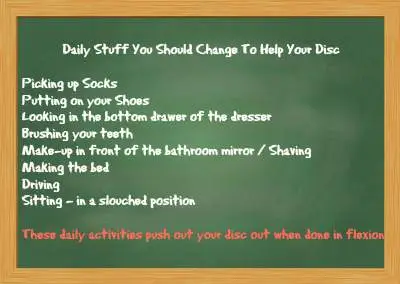
- Adjust Daily Habits: Learn to perform everyday activities in spine-friendly ways to prevent further disc damage.
- Disc-Specific Exercises: Exercises can help reposition the herniated disc.
- Stabilization Routines: Strengthening your core helps maintain spinal integrity, preventing future herniations.
Lifting Techniques: How Weight Lifters Should Lift
Master the Basic Butt-Lifting Technique for Disc Health
- Practice with a long, straight object to ensure your back remains aligned.
- Ensure it touches your butt, mid-back, and the back of your head during the entire motion.
- Squat down and maintain contact with 3 areas and keep the lower back arched the whole time.
- Aim for 30 repetitions to embed this healthy habit into your daily routine for 10 days
Daily Activity Guide: Protecting Your Discs
Then you integrate this lifting technique into everyday life. Initially, whenever you do any of these activities, use the same basic move and you will stop pushing out your disc.
In the beginning, you will need to be conscious each time you are doing any of these activities. To speed things up you can practice each activity like picking up your socks 30 times using the butt lifting technique and it will become even more automatic. You can deepen muscle memory during all of these activities.
For sitting in a chair and driving I recommend that you roll up a Mckenzie Lumbar support roll and put that in the arch of your lower back
Guide for disc herniation daily activities.
- Remember to do all these movements pain-free. Always stop whenever you run into pain with any movement of the spine.
- Disc herniations are linked with long periods of sitting, especially prolonged driving.
- Disc herniations are caused by repeated flexion.
- Prolonged trunk flexion or twisted or bend sideways cause disc herniations.
- Too much lifting, pushing/pulling causes disc herniations
- Vibration while sitting is linked to disc herniations.
- After prolonged stooping or sitting, you should stand. For example, a gardener lifting bags of peat moss after having a prolonged period of rounded lower back, or a driver getting heavy loads out of the trunk after a long drive is not recommended. You should remember to stand for a few minutes before attempting to lift. Studies have shown that ½ hour is even better.
Here are some more exercises that can cause disc herniation.
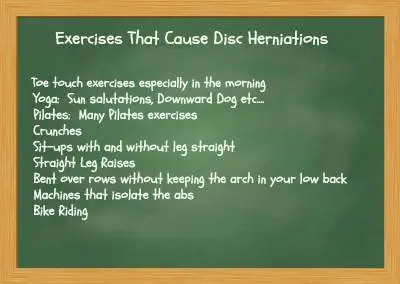
Activities That Put Out Lumbar Disc Herniations
Yes, it’s very surprising that toe touches, Yoga and certain Pilates can cause disc pressure leading to disc herniations. I have personally treated dozens of Yoga teachers with varying degrees of experience. The fact is some of the exercises involved in Yoga are great for helping disc herniations while others directly push the disc out.
Many Yoga Exercises Put Out Disc Herniations
I know many Yogis who have had to stop many of their exercises due to the pain it cause them in various parts of the body, including their disc.
Next week’s article will go over the second and third ways to help your disc. Remember, you need to do #1 “Daily Disc Activities Correctly” first so that your disc doesn’t keep getting aggravated. Then you can move on to next week’s article which goes over #2 Disc Exercises to Push the Disc Back In and #3 Stabilization Exercises help by keeping the disc from coming out by normalizing how your spine moves.
Looking Ahead: Comprehensive Care for Disc Health
Next week, we delve deeper into specific exercises for disc realignment and stabilization techniques, in this article called Ultimate Guide To Exercises For Lumbar Disc Herniation Relief. Remember, starting with correct daily activities is essential to prevent aggravating your condition further.
Tell us what you think in the comments below and like us on Facebook. This Toronto Downtown Chiropractor will answer all questions in the comments section.
Related Categories: Disc Herniation, Low Back Pain, Surgery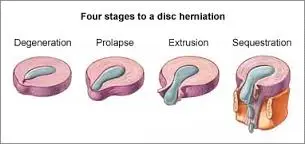
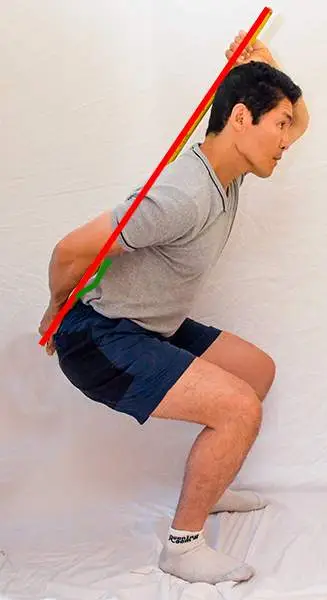

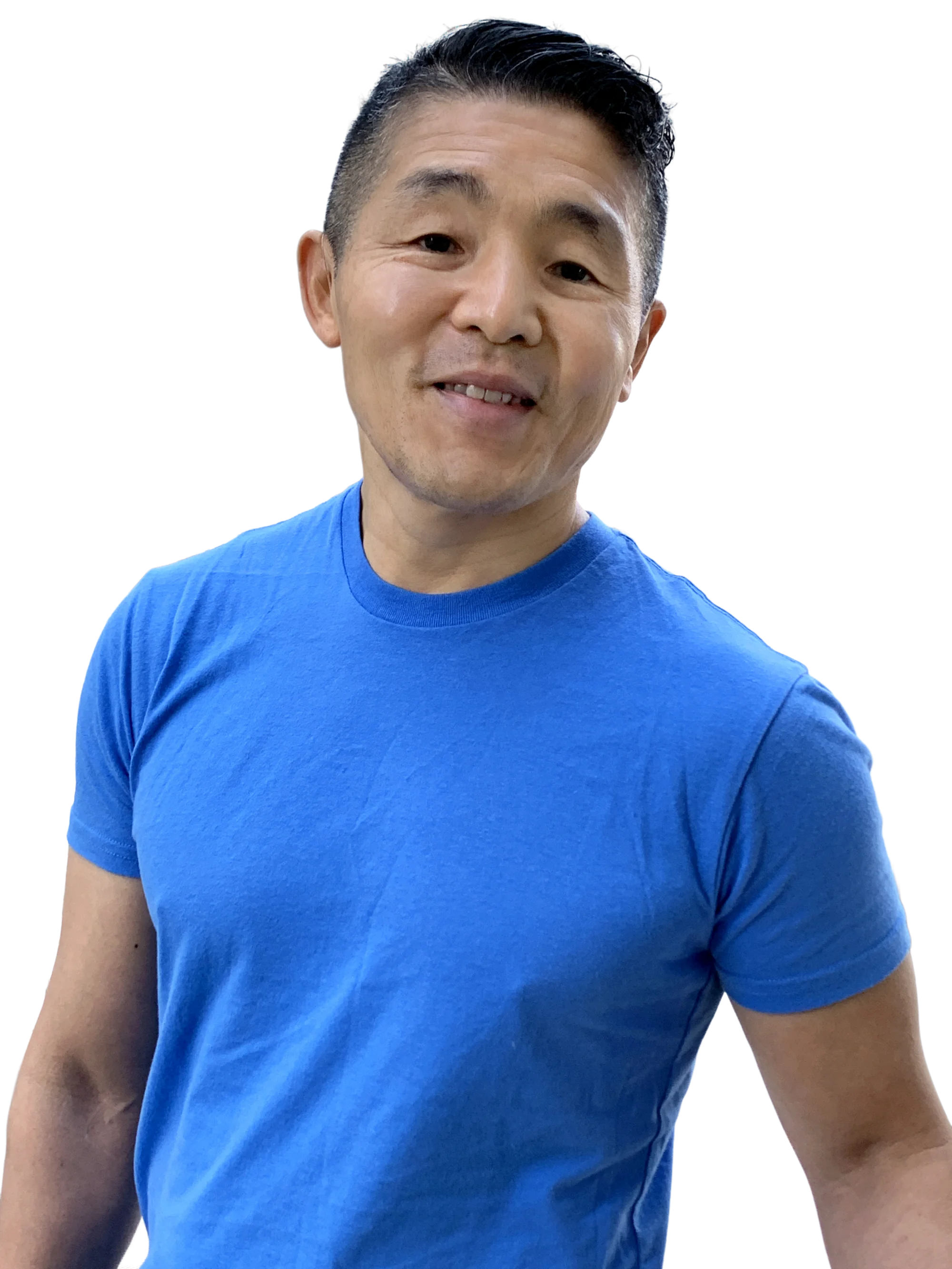
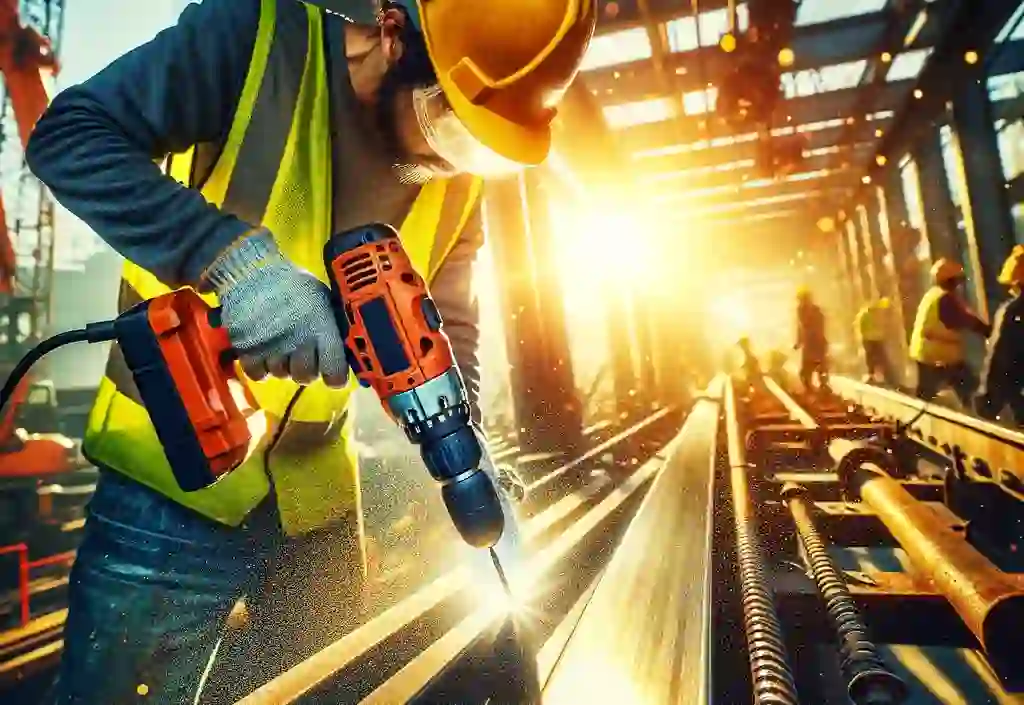

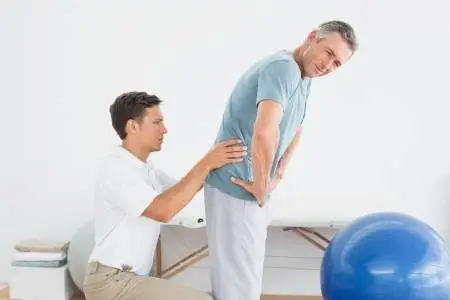
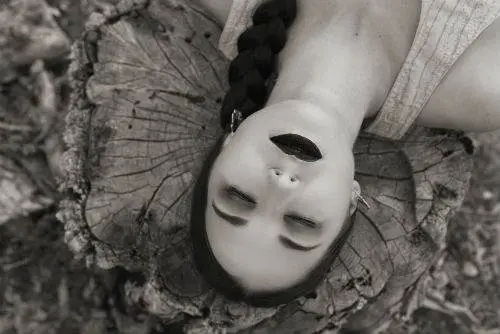
Hi dr , I lifted something wrongly in Aug 2021 , I felt pain 4 days later no , after few months i was standing for 30m talking frnds , a pain started in right leg till down .
Jan 24 ,2022 ,So i went to doc my mri report says mild disc Bulge at L5/S1 ,causing thecal sac , with no stenios no nerve impingement.
Ap diameters are all 13.x L1-L3, l4 is 12.5 , L5 is 11.5 mm.
I’m getting pain in leg fingers , 2nd and 3 finger both legs . Sometimes I’m getting pain while sitting at buttock areas sometimes left sometimes right . I’m getting pain in joints and at Front of thigh and front calf sometimes .
One physico said ur bulge will not go back as scar tissue is created and disscated .
I’m worried about life , a lot from India . Can u tell me what to do.im 27 not married no job .
i Ken,
I have lower back pain which radiates to left foot. Doctor recommended for 3 weeks physiotherapy after doing a MRI.
Now I’m in my 1st week of physio. I can bend forward backward and both side ways. Only from left to right sideway movement i have pain on left hip.
Mostly the pain is on my left Hip.
Im Correcting my sitting posture to 100 degrees and cant feel any pain in back. But a discomfort or a small pain radiates in my left leg to feet.
The MRI reveals as below /
At L4/L5 level,
Diffuse disc bulge abutting the thecal sac and bilateral L5 traversing nerve roots.
The bilateral neural foramens are narrowed.
The exiting nerve roots are intact.
Central canal measures 1.2cm.
No facet arthropathy or ligamentum flavum hypertrophy.
At L5/S1 level,
Diffuse disc bulge abutting the thecal sac.
The bilateral neural foramens are narrowed.
The exiting and traversing nerve roots are intact.
Central canal measures 1.2cm.
No facet arthropathy or ligamentum flavum hypertrophy.
Need ur advise if the physio will help reducing the pain.
Hello, I’m a 23-year-old young patient with a plica on my knees and an extruded hernia on my waist, doctors recommend surgery, please recommend me a treatment method
Hi Dr. Ken!
I need your help, I am having a hard time finding a professional during this crisis to provide an opinion.
I just received my MRI results from my doctor. She wants me to go back to the Physio but no Chiro.
–T12-L1 small paracentral disc protrusion.
I have been suffering with mid-lower back pain for about 10 years, with the last year being the worst. I am 29 years old.. The pain radiates from my mid back down the sides to the lower back and down to my hips. Before my MRI, I have tried stretching, yoga, physio, chiro, I even lost weight (190 lbs to 140 lbs, I am 5’5″). Nothing helped.
I have been quite sedentary the last few years and I work at a desk. I have the worst posture and I cross my legs. I have tried to stop these bad habits but I always find myself doing them because I am so focused and concentrating on my work. My job is extremely stressful with tight deadlines.
I believe my pain is due to my lifestyle and lack of muscle strength. I had gotten a gym membership last year and hired a personal trainer, in the 6th session. I had a really awkward experience. I was doing an Abdominal workout with a medicine ball. A few muscles contracted in a place that should not have been contracting like below the waist. It was the most humiliating experience ever. So I stopped seeing that personal trainer. I had a really hard time on my own at the gym, I ended up quitting. I felt like I didn’t know what I was doing and that I was wasting my time. I had given up on myself, i had become unmotivated and I gained about 30 lbs.
Since working at home during this quarantine I am finding more energy to start moving and I want to develop a better routine and incorporate healthy exercise at home. (I feel less stressed from not having to go into work).
For the T12-L1 small paracentral disc protrusion, what muscles do you recommend strengthening? What exercises would you recommend to help fix my issues? Is there any advice you could give me?
Thank you so much for reading this. I hope I hear from you 🙂
Author
Thanks for your questions Karleigh. I would work on the exercises here as well as these exercises. https://www.bodiempowerment.com/herniated-disc-part-2-the-best-exercises-for-your-herniated-disc/
This is an opinion and not a recommendation.
Hope that helps.
Dear Sir,
Please advise the steps to cured from the following details of MRI.
Mild diffuse bulge of L4-L5 and L5-S1 discs are seen with broad based posterior disc protrusions causes thecal sac compression and mildly impinging on the bilateral traversing nerve roots.
Vertebrae show normal size, signal intensity and alignment.
Spinal canal is of normal dimension.
Conus ends at normal level with normal cauda equina & conus medullaris.
Lower dorsal cord is normal in size and signal intensity.
Facet joint and ligamentum flavum are normal..
Paraspinal muscles are normal in size and shape with normal signal intensity.
Rest of the intervertebral discs are normal in height and signal intensity.
Spinal Canal measurement at various levels.
L1-L2 Level – Canal – APD 19.0 mm
L2-L3 Level – Canal – APD 20.0 mm
L3-L4 Level – Canal – APD 18.0 mm
L4-L5 Level – Canal – APD 13.0 mm
L5-S1 Level – Canal – APD 12.0 mm
IMPRESSION :
MRI of lumbo sacral spine shows :
Early degenerative disc disease with
Mild diffuse bulge of L4-L5 and L5-S1 discs with broad based posterior disc protrusions causes thecal sac compression and mildly impinging on the bilateral traversing nerve roots.
Author
Thanks for your question. By only posting your MRI I cannot give you an opinion as I need context. The MRI isn’t a diagnosis. The MRI result has to correlate the history and exam, thus I have nothing to correlate.
Sorry that I cannot give you an opinion in your case.
I have a torn ligament at L5 S1, allowing a mildly bulging disc to touch the nerve causing sciatica with pain in the right buttock and tingling in the toes of my right foot. I’m doing physiotherapy for the next 6 weeks and have been told to limit activity, avoid lifting and household chores etc. Is there anything else I should be doing so that the ligament will heal properly and should I avoid sitting or laying down? At my first visit they had me do 50 straight leg raises with my right leg which was not painful and then put the ultrasound/magnetic pad on me for a while. I’d like to know what to expect and if this treatment sounds appropriate for a torn ligament.
Author
Thanks for your question, Deanne. Sounds like your physiotherapist is trying to floss your nerve meaning trying to move the nerve back and forth just like you would dental floss back and forth between your teeth. The idea is that the nerve will be freed from the adhesions thus helping your sciatica. As long as it doesn’t cause increased pain afterwards this is appropriate. When you say “torn ligament at L5S1”. I haven’t come across this. Usually, it’s simply called a disc bulge. My opinion is that an MRI or CT doesn’t show the full extent of the disc herniation as you are lying down in an MRI / CT thus it looks like there is no pressure on the nerve. When in fact when sitting and lifting puts more pressure on the disc and thus the nerve. Thus the MRI or CT doesn’t show the extent of the problem in real life unless you get an MRI taken while sitting or lifting.
Sound like extension exercises are likely helpful but I haven’t examined you in your particular case. You should seek the opinion of someone that can actually examine you. What I am giving you is an opinion and not a recommendation. Hope that helps your disc herniation.
Hello sir, hope you will answer my problem. Actually i started gym in sep’18 but i know some psoture or hamstrings crunches something really affects me in low back, after that i took homeopath medicine and leve gym and the pain went out. After 1 month i again joined gym and it didnt started paining but after sometime my pain started and till today i can say i can do gym but i feel something is there in my back causing me uncomfortable after waking, causing not to stand more time. I do some yoga but it didnt relief me and am overweight as BMI is 27%. But plz if you can help plz do.
Author
Thanks for your question Shreyansh. I think you are saying you don’t do any hamstring stretches and crunches. Also, you need to have good posture. If you don’t then you need to have a lumbar support roll for your chair if you are in an office job. With the support roll you need to lean back in your chair not 90 degrees but approximately 100 degrees. This way it doesn’t take any effort to keep your posture. In addition, you need to stand up once an hour. The other thing to keep in mind is at this time to avoid deadlifts, squats and military presses at this time as they will compress your spine. Exercises like pull-ups pulldowns, dips are helpful while the ones I mentioned are usually not helpful when the pain is too acute or you are recovering. Later on most of these exercises can be done if they are done properly.
The above is an opinion and not a recommendation.
Hope that helps. If you have any more questions for this chiropractor I will do my best to answer them.
Sir Namste
Sir my MRI report show that
“Mild disc desiccation, diffuse bulge with postero-central protusion of L4-L5 disc indenting the thecal sac and causing mild impingement of left traversing L5 nerve root. Bilateral foraminal stenosis mild foraminal stenosis with no evidence of neural compression seen”
What is do sir. plz give me suggestions.
Author
Thanks for your question Sompal. I cannot give you an opinion solely based on an MRI. You will have to write a lot more about your symptoms so that I can get a proper history of your condition.
Hope that helps your possible disc herniation.
Tuve una hernia de disco hace ya un año y no hice reabilitacion y me cuesta moverme
Author
Thanks for your question Daniel.
Google translate: “I had a herniated disc a year ago and I did not re-habilitation and it’s hard for me to move”.
It’s not clear if you have pain or just from stiffness or you have pain and stiffness as a result of the pain. It may be beneficial to do the exericses in this article and here. https://www.bodiempowerment.com/herniated-disc-part-2-the-best-exercises-for-your-herniated-disc/
However, it is always best to have an opinion from a local professional since they can examine you and I cannot.
Hope that helps your possible disc herniation.
HELLO
AGE IS 56 AND MALE
FROM AGE OF 40 SEVER SPASM OF MY LOWER BACK INITIATED BECAUSE OF BAD LIFTING OF HEAVY THINGS WHICH TREATED BY SOME DRUGS SUCH AS DICLOPHENAC
FROM AGE OF 52 EVERY MORNING WHEN I AWAKE MY LOWER BACK IS VERY STIFF AND HARD THAT FLEXING IS PAINFUL AND IMPOSSIBLE BUT AFTER SITTING ON A CHAIR FOR 30 MINUTES
IT DISAPPEARS .BY EATING DICLOPHENAC IT DISAPPEARS QUICKLY.PLEASE HELP ME.
Author
Thanks for your question Kaveh. You should try these exercises first. You should do extension exercises like this: https://www.bodiempowerment.com/herniated-disc-part-2-the-best-exercises-for-your-herniated-disc/
Also the fact that diclofenac helps means that you have inflammation in your body, otherwise it would not work. So you should not use vegetable oil. Use coconut oil, eat fish every day, no meats and eat plenty of fruits and vegetables.
Hope that helps your lower back. The above is an opinion and not a recommendation.
Dear Dr. Ken,
I have this peculiar pain in my left leg, starting from the center of my lower back to my left buttock and all the way down to my feet, it has swollen a bit under my ankle and ends in the sole of my feet.
I notice that my left hip bone is a bit “out” than the right, does this mean the bone has missed its spot?. What should I do to relieve the pain?.
Hoping on your prompt reply,
May God Bless you!
Author
Thanks for your question Abay. You should try the exercises in this article and this article here. https://www.bodiempowerment.com/herniated-disc-part-2-the-best-exercises-for-your-herniated-disc/
If you have any questions I will my best from my little Toronto office to help. The above is a opinion and not a recommendation. Hope that helps your disc herniation.
I have S1 hernniation on the left and cannot to a toe raise. My calf muscle is shrinking and gait with limp. Numbness in foot, heal and pain in button and behind the knee. I am still active, can climb 10 flights of stairs. What should I do? Note I had a previously hemi Kanu L5 4 years ago with excellent results.
Hemi laminectomy I meant. Thanks for any insight you might have. Kathi
Author
Thanks for your question Kathi. I would have a consult with a neurologist first before doing anything.
Hope that helps your disc herniation.
After reading this post and comment i have clear my mind about this topic such a great post thank you for this information.
Author
You are welcome, Khalid.
Hello Doctor,
My name is Saeedeh.
I live in the Netherlands and diagnosed with herniatedd disc L5/S1 6 months ago.
I had FT and heavy painkillers for months. The exercises in part 2 of your blog are the same as which I got from my therapist. IT is 6 months and I am better, however, I have still alot of pain in my leg and feet. Recently I have noticed that when I do Cobra pose and the extension both my legs feel a little numb. Furthermore, my vertebral column feels vers stiff.
Is it possible that I have done these exercises for too long.
How van I reduce the pain in my feet?
Sorry for my English!
Author
Thanks for your question Saeedeh. I assume that when you say FT you mean physiotherapy or fysiotherapeut in Dutch. Likely your disc has changed. I think you need a new FT or chiropractor. When you have leg and feet pain and no low back pain that is clearly worse, not better. If your FT or physiotherapist said this is better that is generally not the case. There are exceptions but from what you have told me you are worse.
Hope this leads you in the right direction for a disc herniation. I cannot give you exercises to do as you are worse and I would need to examine you to determine which exercises to give you. If you have any more questions for this downtown Toronto chiropractor I would be my best to give you a good answer.
Tank you very much for your respond. Now I am very confused and sacred. My fysiotherapist and neurologist told me that I can begin to work as I have progress. They say that the pain in my feet will take at least one year to go a way. Now I am sure that this is not right.
I just like to explain that I have now only pain under my right feet on the both side. It is like burning the entire day while sitting and standing too long. I can only sit for half hour. After that I need to stand up and walk otherwise it will get worse. What should I do?
Many thanks in advance!
Author
Thanks for your comment Saeedeh. Remember one key point, I did not examine you. You could be an exception but it doesn’t sound like it. I would do the exercises here in this article and also in the following link. https://www.bodiempowerment.com/herniated-disc-part-2-the-best-exercises-for-your-herniated-disc/
This is an opinion and not a recommendation. You can get worse with any exercise. You need guidance from someone that can examine your lower back while doing the exercises.
Hope that helps your disc herniation.
Found advise very interesting and informative
Author
You are welcome, Cathy. You may want to read part 2. https://www.bodiempowerment.com/herniated-disc-part-2-the-best-exercises-for-your-herniated-disc/
Hope that helps.
Thank you for your info. I have found it very helpful and insightful. Am in a forgein country at the moment and chiropractic services are not readily available. I had been diagnosed with 2 small herniations of L5/S1. I had no sciatica, but weakness in lower back and some sharp pains at times in the same region with reduced mobility. I have worked up to Cobra after a few days and all pain is gone. Question is, at what point do I slow down on Cobra every 2 hrs? And to how often? And when can I start to do strength exercises for the lower back? Thank you for your help
Author
You are welcome, Matthew. That’s great that you have no more pain. You can a couple sets a day for a further 6 weeks. After that, you can stop the exercises (Cobra). You can also start these exercises for strength and stability.
Hope that helps your disc herniation. If you have any more questions for this downtown Toronto chiropractor I would be more than happy to answer your question.
Dear Doc Ken Nakamura
I am Karimi had L5 S1 Decompression Surgery back in 2001, after recovery had some ups and downs.
Now I am training to get into Job which involves driving not long distances but the amount of unloading is lot like 30 to 35 Drops per shift weighing max of 18kg some times lifting flights of stairs, basically going to work for an online Groceries, foods and drinks. it’s called Ocado.
I’m really worried I might fall back and injured my back again please any advice should I continue or quit the job?
as I already feeling some nume and tingling on my legs.
Thanks
Author
Thanks for your question Karimi. I can’t tell you if you should quit your job or not but I can show you how to lift. https://www.bodiempowerment.com/weight-lifting-techniques-smarter-than-chiropractors-how-to-use-back-safety-lifting-techniques/
Practice the techniques many times to lift properly. Also, do these exercises. https://www.bodiempowerment.com/herniated-disc-part-2-the-best-exercises-for-your-herniated-disc/
The above is an opinion and should be done with a professional. Any exercise can make you worse that is why a professional is important. If you have any more questions I will try my best to answer them for you.
Hope that helps your disc herniation.
Hello Dr.Ken,
I have a long-standing back problem from over 25 years ago where I ruptured my disc between L4 and L5. Recently I had a hiking accident where I ripped out my AC joint grade 4 / 5 injury. Along with that it seems I have exacerbated my back issue and we are before mild symptoms in my feet have turned into more noticeable symptoms and my right leg and buttock are also getting involved with paresthesia. It would seem there is some sort of nerve root compression . What can I do to help improve this situation without surgery? Currently I try to walk everyday and avoid sitting as much as possible, the rest of the time I’m laying on my bed on a angled cushion with lumbar support. Currently I’m not having any pain. Thanks for any suggestions!
Author
Thanks for your question Wyatt. So you are saying that you don’t have any pain but you all your symptoms are paraesthesia in your back, buttock, leg and foot. I am assuming you don’t have symptoms in both feet and only the right foot or if you have symptoms in both feet that they are unrelated to your lower back. You can do the exercises here in this article and also here.
https://www.bodiempowerment.com/herniated-disc-part-2-the-best-exercises-for-your-herniated-disc/
Hope that helps your disc herniation. If you have any questions for this downtown Toronto chiropractor I would be happy to answer them.